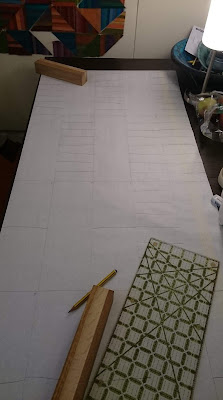I've also found the perfect solution, which is to alternate the wheelchair quilt with the temperature quilt. I sew four units of the wheelchair quilt, get them sewn into a column and attached to the previous column, then do one catchup day of the temperature quilt, and switching back and forth keeps me happy and motivated. I'm now caught up back to the start of April, working backwards.
I should have put more gold in my fabric range, and am worried that I'll run out of the ombre fabrics for 12° and 17°, but otherwise its going well and starting to look very nifty. I joined Instagram, where there's a nice little community for making temperature quilts, and here is a mini tutorial I posted there on how I use freezer paper piecing for making the temperature quilt.
Another odd thing about making the wheelchair quilt is that the pieces are 40% smaller when sewn than when they're laid out with their seam allowances showing, as they're only 3" half square triangles, and it throws me to see them together. I'm not sure why, maybe my brain is insisting that the smaller pieces are further away, and then realising that's not the case? Now that it's two-thirds sewn, it seems to be snapping back into making sense for my head, thankfully.
Something I only realised about myself in the last year or so is just how neurodivergent I really am. It looks like autism and ADHD, though getting diagnosed as an adult woman is very hard, so I may never know officially. It is making it much easier to work out how different things exhaust me, which is an ongoing chore when you have ME/CFS wiping you out. Between that and finally figuring out the best way to use my Fitbit data (I colour the tablet status bar in segments to show sleep, steps, heart rate and so on), I'm pacing myself far better. This also means I'm doing more quilting, which is an absolute joy. Well, either I'm pacing myself better, or I'm due for an almighty crash.
I definitely overdid it yesterday, and will need to be doing lots of resting under a cat for a few days. I had finally prepared the huge spiral stencil for R's bedspread, cutting it in between piecing the wheelchair quilt and temperature quilt (three things on the go suited me surprisingly well, I had a nice little routine set up), and brought it over to R's. It's A2, cut in such a way that if you want to make the bigger spirals, there's quite a lot of repositioning.
Then I clipped the quilt onto the board we use to extend R's coffee table for board games, which covers just over a quarter of the quilt, and got half of it marked up over a couple of days. It's surprisingly tough work, especially on the legs, and naturally the marking pens decided to die near the end. I am hoping that the Crayola marker pens wash out as well as I remember, since with crowfooting you don't cover that much of the marking line with stitching. So I'm in exhausted-but-smug mode.
Still, that's several months' quilting prepared, and the quilt is now back on the bed and is a delight to work on. Despite having royally overdone it with the marking, I couldn't resist doing some quilting yesterday, and it is indeed much quicker, easier, and more fun to work on than traditional hand quilting. I've done three spirals so far, and am loving shifting the thread colours gradually for each one. The first one, which is the big extended spiral, was yellow - orange - pink - lavender, then one in four shades of sea green, and now I'm on one in different shades of blue. I keep getting urges to buy ALL THE THREADS, although I have some thing like 80 colours in perle #8 now and shouldn't need to. I admit to sneaking my DMC colour card out to check this morning, and there just aren't many of the brighter light blues anyway. I'm sure I'll be fine, I have boxes and boxes of thread.
Here is the quilt on the bed, being approved by the cat. You can see some of the crowfooting on the left. I really like the effect I'm getting with the different coloured lines of stitching curving over the black sashing in particular.
Here is the quilt on the bed, being approved by the cat. You can see some of the crowfooting on the left. I really like the effect I'm getting with the different coloured lines of stitching curving over the black sashing in particular.












